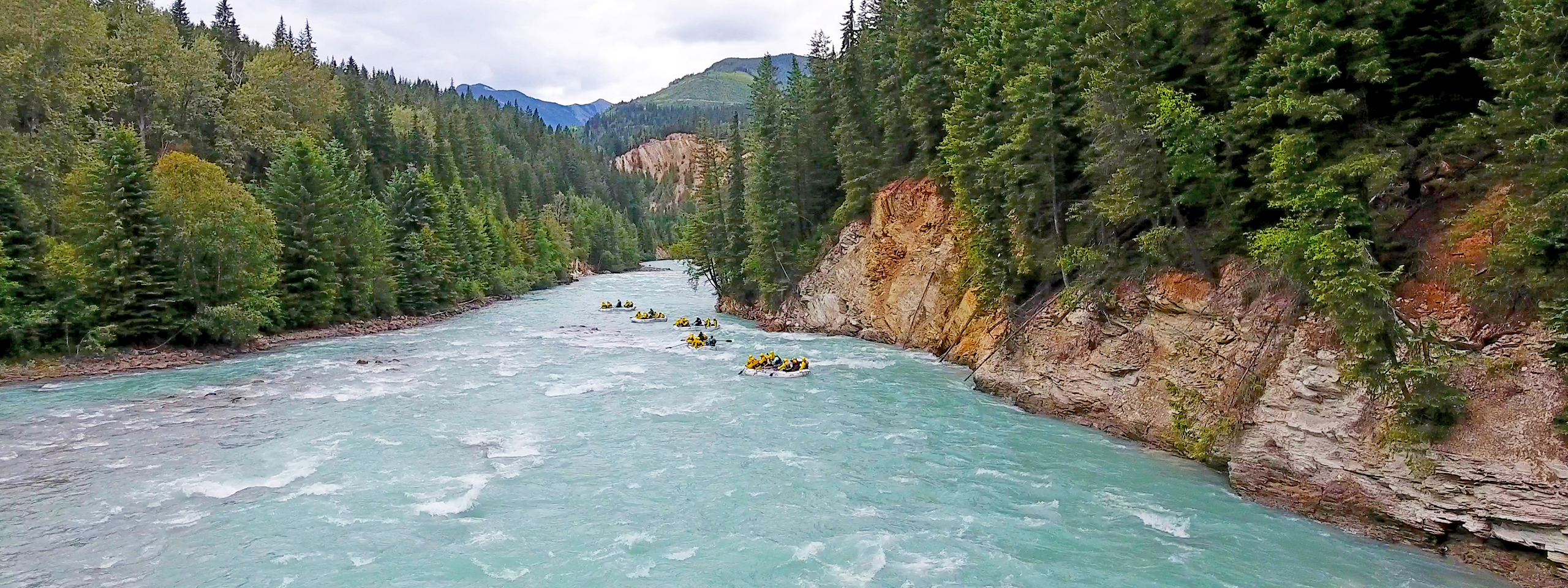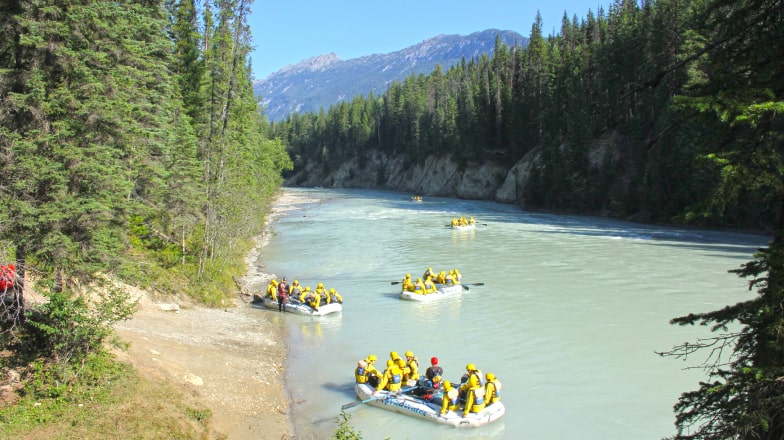
Kicking Horse River Rafting Info
The Kicking Horse River is renowned as the best whitewater rafting in the Canadian Rockies. Different sections of the Kicking Horse River offer different classes of whitewater making it perfect for family rafting trips, first-time rafters, and those seeking the most exciting river trip.
Kicking Horse River Heritage
The Kicking Horse River earned its rather rowdy name back in 1856. A young Scottish explorer, James Hector, was propelled into the swift and swollen river courtesy of a mighty kick from his angry and tired packhorse. The kick to James Hector’s chest rendered him unconscious for two hours, with a pounding headache lasting for several more! The event was sufficiently noteworthy for his travelling companions to change the river’s name from its original Stoney First Nations, ‘Wapta’, to ‘Kicking Horse’.
The Kicking Horse River and its tributaries (the largest being the Yoho River) drain a spectacular landscape of massive icefields, canyons, gorges, cliffs, avalanche slopes, and mountain peaks ranking amongst the highest in the Canadian Rockies.
The Kicking Horse River system is fed by small timberline lakes and glacial meltwater streams with colourful names such as Ottertail, Otterhead, and Beaverfoot. The river’s personality varies with turbulent rapids, jaw-droppingly beautiful waterfalls, and braided streams meandering through valley flats near the town of Field, BC.
Two of the largest waterfalls are Wapta Falls (just 4km upstream from the Wild Water Adventures River Base) and the jaw-dropping Takkakaw Falls in Yoho National Park. Both waterfalls are easily accessible from the TransCanada Highway.
In 1990, the Kicking Horse River was designated as a Canadian Heritage River for its historical, cultural, and recreational significance, one of only 3 in the province of British Columbia.
Photo credit: Parks Canada

Kicking Horse River Classifications & Descriptions
Rivers have a wide variety of personalities. Not all are raging torrents of water as depicted in Hollywood’s ‘The River Wild’! Different rivers have different features; even different sections of the same river can be completely different. The Kicking Horse River, for example, is 80 kilometers long but only a quarter of that is actually runnable by raft. Some sections are braided and shallow with hazardous logjams. Other sections are just too steep and dangerous.
The International Scale of River Difficulty classifies individual rapids on a scale of 1 through 6. Class 1 is easy whereas Class 5 is nearly impossible; Class 6 is unnavigable. A rapid may vary in terms of the time it takes to run. Some rapids take only a few seconds whereas others may take 20 seconds or more. Portage and Shotgun rapids, on the Kicking Horse River, cover approximately 1 kilometer of river distance. That’s a good minute or two of non-stop whitewater action!
Here are the six tiers of Rapid Classification:
Remember: This scale is subjective. Grading of rapids can fluctuate from season to season, day to day, and sometimes hour to hour. This scale is meant only as a guideline for how easy, or difficult, a rapid or section of the river may be. Contact our knowledgeable reservations agents to learn more about the typical river levels at the time of your trip departure.

Class 1 Rapid
Wild Water definition: Very relaxing.
Gentle, moving water. Very small waves require little or no maneuvering.

Class 2 Rapid
Wild Water definition: Guests may get splashed.
Regular waves, easy to see, may reach 3 to 4 feet in height. Simple maneuvering may be required to avoid rocks, river bends or other obstacles.

Class 3 Rapid
Wild Water definition: Guests will get wet!
Large, continuous series or sets of waves, some in excess of 6 feet. ‘Holes’ or hydraulics may be present which could be rafted or avoided. Small drops, ledges or waterfalls may be present. Scouting the rapids is suggested for all but the most experienced of river persons.

Class 4 Rapid
Wild Water definition: Guests will get soaked . . . like a 9 or 10 on the ‘fun scale’!
Confused and erratic waves or holes. Large obstructions need to be avoided in what is referred to as ‘must moves’. Risk of injury if swimming without the benefit of a raft. Very difficult. Scouting is required.

Class 5 Rapid
Wild Water definition: Adrenaline junkies only!
For most people, Class V goes off the ‘fun’ scale and enters the ‘kinda scary’ scale! Very challenging for even the most experienced river persons. High risk of capsize or injury. Limited navigation. Scouting is essential.

Class 6 Rapid
Wild Water definition: Niagara Falls in a barrel!
Virtually non-navigable, or navigable only at particularly favourable river levels.
